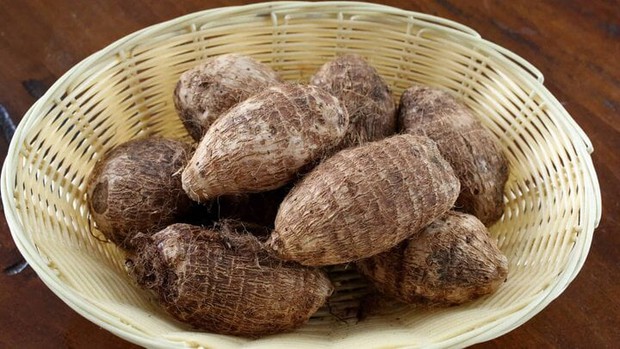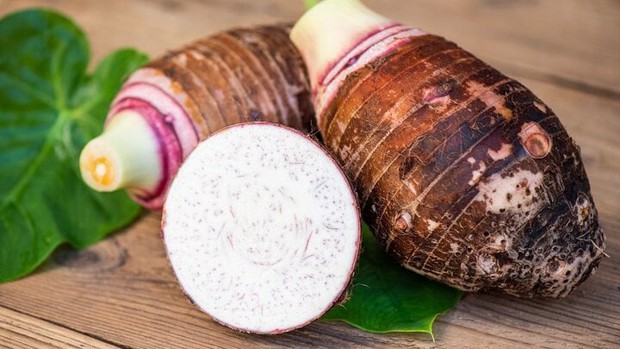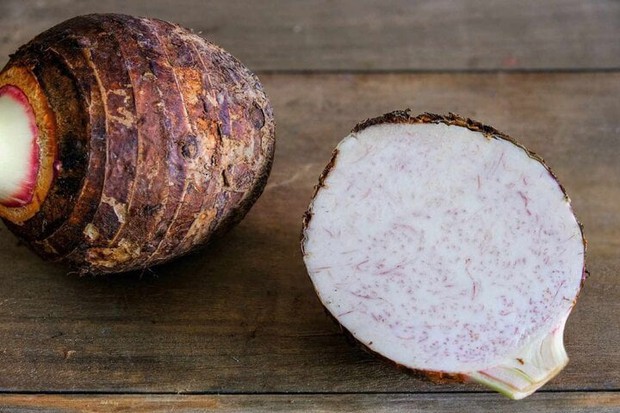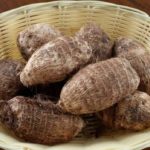Taro is a very healthy food and has many ways of processing, creating delicious dishes that many people love. You can use it for frying, boiling, stewing, soup, dessert, or making cakes, all of which are delicious.
Should you choose big or small taro?
If you don’t buy carefully, consumers can choose low-quality and unappetizing tubers. One of the concerns raised by many people is whether to choose big or small taro.

Choosing big or small taro is something that many people hesitate. (Photo: Maangchi)
The weight of taro tubers is one of the important criteria for choosing this food. In general, when buying taro, we should choose tubers that feel light. According to the experience of growers, light taro will contain less water and have a high starch content, usually firm, and more fragrant. Heavy tubers contain more water, usually taste very bland, easily decayed, and less delicious.
Therefore, you don’t need to worry too much about whether to choose big or small taro, pay more attention to the weight of the taro tuber.
Tips for choosing delicious taro

To buy good taro, you also need tips. (Photo: Eater)
In addition to basing on weight, paying attention to the following factors also helps you choose the taro tuber you desire.
Look at the appearance
When choosing taro, you should observe the external shape of the taro tuber. Because taro is dug up from the ground, they often have dirt sticking to the outside. If there is still dirt sticking to the surface and the soil is relatively moist, it means that the taro is newly dug up and still very fresh. If the surface of the taro is free of dirt or the soil has dried out, it means that the taro has been stored for a long time, and the flesh inside may be slightly withered. These tubers are often easily decayed.
Look at the eyes of the taro
The hollow parts on the taro are the eyes of the taro tuber. Whether taro is fragrant and delicious or not has nothing to do with the number of eyes. The more eyes, the more soft, fragrant, and delicious the taro tuber is.
On the other hand, taro tubers with few or no eyes are often less delicious.
Color and texture of the taro

When the taro tuber is cut in half, the more purple lines you see, the more delicious the taro is. (Photo: Storables)
Large taro will usually be cut in half for sale. At this point, you can observe the cut surface of the taro, if you see a lot of light purple veins mixed with white color in the taro, it indicates that the taro is delicious. Conversely, if the inside color is pale and the veins are sparse, the taro is usually not delicious and should not be chosen.
In addition, you can also use a knife to gently scratch a line on the taro tuber. If a little white, milky liquid flows at the scratch, and when you touch it lightly, you feel sticky and quickly dry up, then this is a taro with a lot of starch, high quality.
The health benefits of taro
Taro is one of the most nutritious types of tubers, with many health benefits:
Improves digestive health
One of the biggest benefits of taro is stimulating digestive activity. Taro contains a large amount of dietary fiber, which is very beneficial in supporting a healthy digestive system.
Taro also helps prevent issues such as bloating, indigestion, constipation, and even diarrhea. A healthy digestive system can enhance overall health and reduce the risk of cancer.
Prevents cancer
Taro has polyphenols, natural antioxidants that have many health benefits, including cancer prevention.
Quercetin is the main polyphenol found in taro, also found in apples, onions, and tea. Quercetin can inhibit the development of cancer cells. It has antioxidant properties, supports apoptosis, and prevents the proliferation of cancer cells in different stages.
Furthermore, taro also contains cryptoxanthin, which can prevent throat and lung cancer.
Balances blood sugar
People who consume low glycemic index foods will have a lower risk of heart disease and diabetes. Taro has a low glycemic index naturally, which helps diabetes patients effectively control their blood sugar levels.
Taro also supports blood sugar balance, reduces and controls lipids and triglycerides, helping with weight loss and maintaining body mass index – BMI. It has many nutrients like protein, calcium, thiamine, phosphorus, riboflavin, niacin, and vitamin C to maintain good skin and overall health.
Prevents heart disease
Taro contains a good amount of starch and dietary fiber. Doctors recommend ingesting good dietary fiber to prevent cardiovascular and coronary artery diseases. Dietary fiber plays a vital role in reducing LDL – bad cholesterol. Resistant starch in taro reduces insulinemia reactions, improves whole-body insulin sensitivity, increases food satisfaction, and reduces fat storage.
Boosts immunity
Taro plays an important role in boosting immunity, antioxidant activity, reducing blood sugar levels, regulating immunity, and antibacterial effects. Antioxidants neutralize free radicals in the body and prevent cell damage.
Supports weight loss
Taro has an average glycemic index, along with a high amount of dietary fiber, which is a necessary characteristic to support the weight loss process and maintain blood sugar levels in the body. Besides, taro also provides essential minerals such as magnesium, calcium, potassium, phosphorus, iron, and zinc and beneficial fiber for health. Fiber helps us feel full longer, so we consume fewer calories.
When selecting taro, it is important to consider its weight, appearance, and eyes. Choose taro that feels light for its size, as this indicates lower water content and higher starch content, resulting in a firmer and more fragrant vegetable. Look for dirt on the surface, which suggests it is freshly dug up. Additionally, examine the eyes of the taro; a larger number of eyes indicates a softer, more fragrant, and tastier vegetable.
- Improves digestive health by stimulating activity and preventing issues like bloating, indigestion, constipation, and diarrhea.
- Prevents cancer due to the presence of polyphenols, specifically quercetin, which inhibits the development and proliferation of cancer cells.
- Balances blood sugar levels, making it beneficial for diabetes patients, and reduces the risk of heart disease.
- Boosts immunity and has antibacterial effects, neutralizing free radicals in the body.
- Supports weight loss by providing a good balance of dietary fiber and essential minerals, helping you feel fuller for longer and consume fewer calories.
In addition to weight and appearance, look at the color and texture of the taro. When cut in half, the more purple veins you see mixed with white, the tastier the taro will be. You can also scratch the surface of the taro with a knife; if a white, milky liquid comes out and feels sticky, it indicates a high starch content and good quality.
Taro is a versatile vegetable that can be used in a variety of dishes. It can be fried, boiled, stewed, added to soups, or even used in desserts and cakes. Its mild flavor and starchy texture make it a delicious and healthy addition to your meals.


































